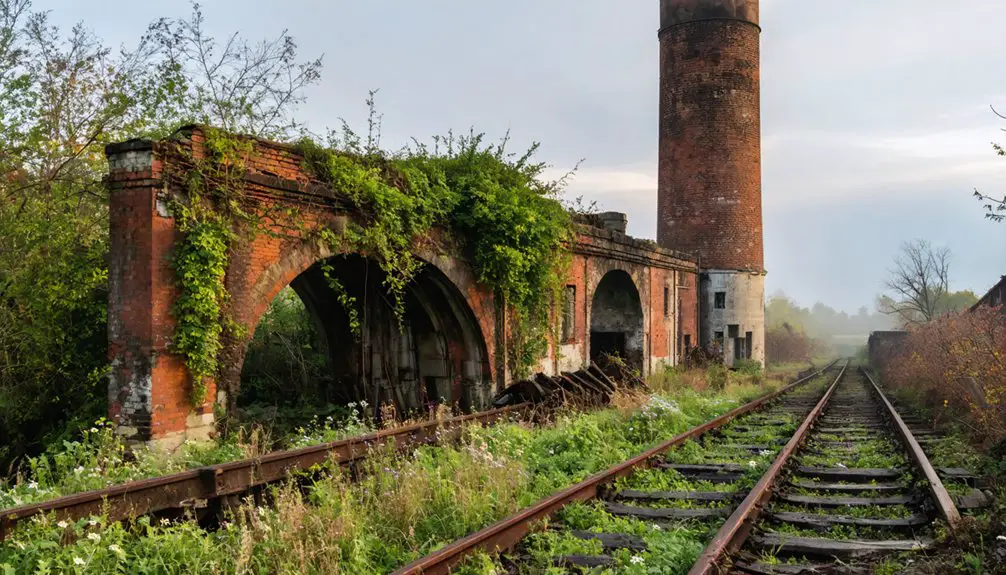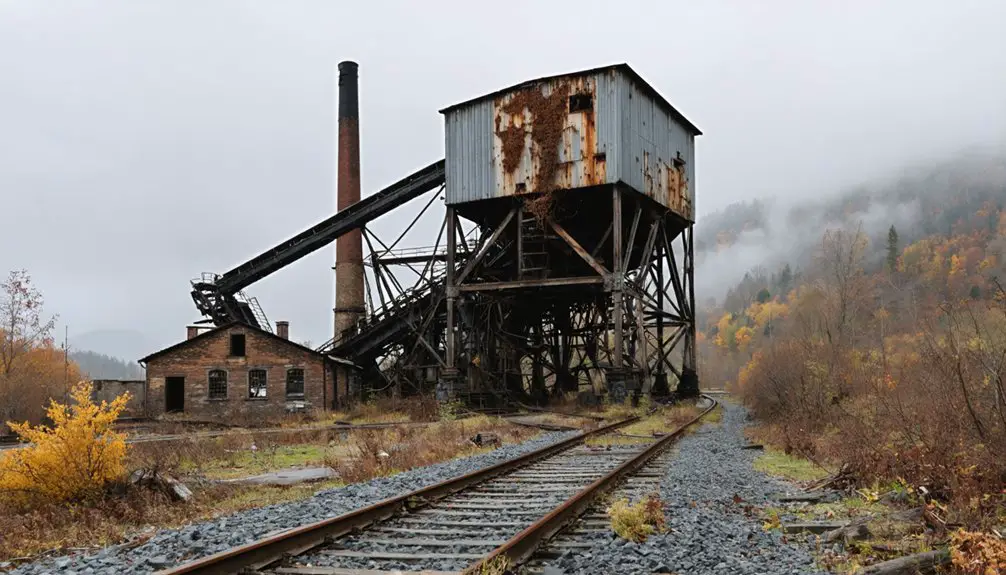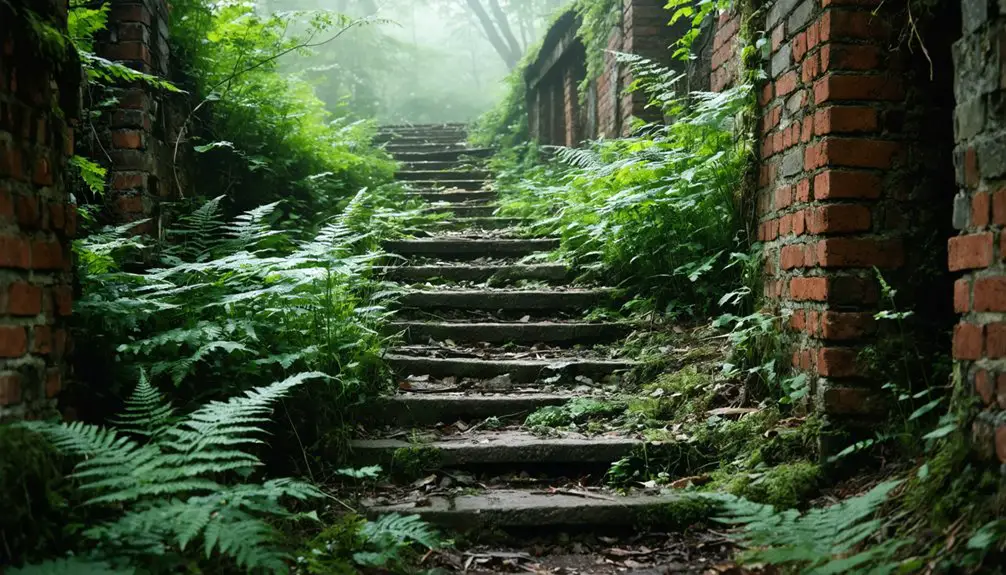You’ll find Climax, Pennsylvania‘s haunting remains along abandoned railroad tracks that once served rich coal deposits. At its peak in 1890, this bustling mining town boasted 2,761 residents, with Ukrainian and Russian immigrants working the anthracite mines. After a devastating underground coal fire ignited in 1962, toxic gases and sinkholes forced most residents to flee, leaving behind empty company houses and crumbling streets. Today’s ghost town tells a compelling story of industrial prosperity and environmental catastrophe.
Key Takeaways
- Climax emerged as a thriving coal mining town in Pennsylvania, reaching a peak population of 2,761 residents in 1890.
- A 1962 trash fire ignited underground coal seams, leading to toxic gases, high ground temperatures, and dangerous sinkholes.
- The mining town’s population dramatically declined from 1,400 to just 63 residents by 1990 due to environmental hazards.
- Two major coal operations produced 638,000 tons before closing in 1942, triggering business closures and community exodus.
- The abandoned town now features overgrown streets, empty company houses, and remnants of railroad tracks from its coal-transport era.
The Birth of a Railroad Settlement
As railroads expanded through Pennsylvania’s remote Appalachian regions in the late 1800s, Climax emerged as a strategic settlement along tracks serving the area’s rich coal deposits.
The railroad significance of this location proved essential, transforming what began as scattered homesteads of pioneering farmers into a bustling company town. You’ll find the mining origins deeply intertwined with the railway’s presence – two major coal operations eventually employed dozens of workers, producing over 638,000 tons of coal before closing in 1942. The area’s challenging terrain was no match for the Climax locomotives’ capability to navigate steep grades and tight curves.
The railway’s arrival transformed isolated farmland into a thriving coal town, where miners extracted vast quantities until operations ceased.
The settlement grew around the tracks, with company housing built near the bottom of town to house the miners who relied on the railroad to transport their extracted bounty. For just a nickel fare, residents could take shopping trips to nearby Bolivar to enjoy ice cream and movie theaters.
Though the mines are silent now, the tracks remain active.
Life in Climax’s Heyday
During Climax’s peak in the early-to-mid 20th century, you’d find over a thousand residents whose daily lives centered around the anthracite mines that dotted the Columbia County valley.
While men spent their days extracting coal through an intricate network of underground tunnels, the town’s business district bustled with general stores, repair shops, and local eateries that served the mining families. Similar to neighboring rich anthracite deposits, these natural resources fueled the region’s economic prosperity. Like other mining communities, the area became home to many Irish Catholic immigrants who arrived seeking work opportunities in the 1850s.
You’d experience a tight-knit community where social life flourished through church gatherings, school events, and local sports teams, creating bonds that held strong despite the physically demanding nature of coal town life.
Daily Coal Mining Operations
When bituminous coal mining reached its peak in Climax, Pennsylvania, the town’s two mines employed 64 workers who faced grueling daily shifts underground.
You’d find miners descending into the coal veins at dawn, equipped with pickaxes and steam-powered drills for coal extraction. Their safety depended on natural ventilation and mechanical fans to clear dangerous gases and dust. These mines utilized the room-and-pillar method, which was standard practice for all underground bituminous coal operations in Pennsylvania. The discovery of anthracite on Sharp Mountain in 1791 had already demonstrated Pennsylvania’s rich coal potential.
Your daily mining experience in Climax would’ve included:
- Maneuvering dark underground passages while operating room-and-pillar mining methods
- Loading extracted coal onto carts and rail transport systems bound for the surface tipples
- Working through brief breaks in designated areas before returning to the coal face
The Climax geared locomotive continuously hauled coal along railway sidings, connecting miners’ hard-won output to broader industrial markets in western Pennsylvania.
Community and Social Life
Energy pulsed through Climax’s community life in the late 19th century, with its population peaking at 2,761 residents in 1890.
You’d find a vibrant mix of Ukrainian and Russian immigrants who shaped the town’s cultural identity, establishing two prominent churches that became social hubs – a Ukrainian Greek Catholic church in 1911 and a Russian Orthodox church in 1916.
The town’s spirit thrived through community gatherings at these religious centers, where you’d experience traditional cultural celebrations that kept immigrant heritage alive. Like other mining communities facing similar circumstances, residents often consulted disambiguation pages to distinguish their town from other places named Climax.
Local schools served mining families’ children while hosting civic events that united the diverse population.
Despite the challenges of mining life, you’d witness a close-knit community where Eastern European traditions, festivals, and shared experiences fostered strong social bonds among residents.
Though residents cherished their town, the burning coal deposits beneath would eventually force most families to abandon their homes.
Local Business and Commerce
At the heart of Climax’s economic importance stood the anthracite coal industry, which fueled a bustling commercial district throughout the late 1800s.
Local entrepreneurship thrived as merchants established general stores, saloons, and banking services to meet the needs of mining families. The retail dynamics reflected the town’s dependence on coal, with businesses adapting to the ebb and flow of mining operations. Like the town of Centralia, the entire community depended on coal mine operations for survival.
You’d find these essential features of Climax’s commercial landscape:
- Rail-connected general stores stocking provisions from distant markets
- Multiple saloons and eateries catering to miners after their shifts
- Hotels and boarding houses serving traveling workers and businessmen
The town’s commerce remained intrinsically linked to the mining industry’s fortunes, with businesses rising and falling alongside coal market fluctuations and labor conditions.
Economic Forces Behind the Decline
If you’d traveled to Climax in the 1960s, you’d have found a bustling coal town where property values reflected the region’s economic stability and mining productivity.
The town’s fortunes changed dramatically when coal production slowed in the 1970s, causing widespread job losses that forced many residents to seek work elsewhere.
Like nearby Centralia, where 2,500 residents once thrived in a prosperous mining community, Climax experienced a similar pattern of economic decline that gradually emptied the town.
Mining Industry Collapse
During the early 20th century, Climax’s mining industry rested on two modest coal operations that employed 64 workers and produced 638,000 tons of coal before their closure in 1942.
Traditional mining techniques couldn’t compete with larger, modernized operations elsewhere, while economic shifts toward alternative fuels diminished demand for bituminous coal.
You’ll find these stark realities of Climax’s decline reflected in:
- Room-and-pillar mining methods that became outdated against more efficient longwall techniques
- Small-scale operations that couldn’t achieve the economies of scale needed to remain profitable
- Company-owned housing that stood empty as miners and their families were forced to seek work elsewhere
The closure marked the end of Climax’s industrial era, triggering a chain reaction of business closures and community exodus.
Population and Property Values
The catastrophic decline of Climax’s population mirrors broader demographic shifts seen across western Pennsylvania’s former mining communities, with particularly stark parallels to Centralia’s near-total exodus.
You’ll find similar population trends throughout the region, where towns like McKeesport have lost over two-thirds of their residents since their peak years.
The property decline in these communities follows a predictable pattern: as residents leave, property values plummet, creating a downward spiral.
When you examine Centralia’s experience, where property condemnation through eminent domain eliminated the real estate market entirely, you’ll understand the devastating economic impact.
The combination of environmental hazards, diminishing municipal services, and demographic shifts has transformed once-vibrant mining towns into areas where property ownership no longer holds sustainable value.
Key Historical Buildings and Landmarks

Several historic structures in Climax, Pennsylvania tell the story of its rise and decline as a coal mining community.
You’ll find architectural features that showcase the town’s historical significance, from the late 1700s Reading Road to the industrial remnants of coal mining facilities and coking ovens. Community buildings, including churches and the Odd Fellows Cemetery, stand as silent witnesses to the once-thriving settlement.
- Railroad Avenue’s abandoned tracks remind you of the bustling coal transport era
- The last house on Locust Avenue, with its distinctive buttressed chimneys, represented resilience until 2007
- The town dump site, where the devastating underground fire began, marks the turning point in Climax’s destiny
Now nature reclaims these spaces, with new-growth forest covering what were once busy streets and neighborhoods.
Notable Residents and Their Stories
While Climax’s physical structures tell one part of its story, remarkable individuals shaped the town’s character through their actions and experiences.
Among the significant events that defined the community’s resilience was the dramatic rescue of Todd Domboski, a 12-year-old who fell into a sudden sinkhole in 1981. His cousin Eric Wolfgang helped save him, demonstrating the tight-knit nature of local families.
Robert Morris, a Declaration of Independence signatory, once owned land here before losing it to bankruptcy. Throughout the town’s history, multiple generations of families maintained deep roots despite mounting environmental challenges.
Even as government officials like Representative James Nelligan and Governor Dick Thornburgh became involved in relocation efforts, some residents chose to stay, becoming custodians of Climax’s enduring legacy.
Natural Resources and Industry

Rich deposits of anthracite coal defined Climax’s industrial identity from its earliest days, with mining operations beginning in earnest during the early 19th century. The coal extraction methods included both surface and underground mining, which powered the local economy and connected the town to broader northeastern Pennsylvania markets.
If you’d visited during the town’s peak, you’d have witnessed:
- Sprawling mine entrances cutting into the earth, with coal cars emerging loaded with valuable anthracite
- Bustling streets filled with miners and their families, supported by shops and services
- A web of transportation infrastructure, including rail lines moving coal to distant markets
The environmental impact proved severe, as mining left the ground unstable and vulnerable to subsidence, ultimately contributing to the town’s decline through the mid-20th century.
The Path to Abandonment
As the fateful spring of 1962 arrived, a residential trash fire in an abandoned strip mining pit ignited what would become Climax’s death knell – an unstoppable underground coal seam blaze.
You’ll find the town’s descent marked by intensifying environmental hazards throughout the 1970s and early 1980s. Ground temperatures spiked abnormally, toxic gases seeped through fissures, and sinkholes emerged without warning.
The most alarming incident occurred in 1981 when a 12-year-old nearly lost his life in a carbon monoxide-filled sinkhole.
Deep community divisions emerged as some residents clung to their homes while others sought escape. By 1983, Congress stepped in with a $42 million relocation program.
The population plummeted from 1,400 to just 63 by 1990, leaving behind a toxic ghost town where few dare to remain.
Present-Day Remnants and Preservation

Today’s Climax stands as a haunting evidence to the devastating mine fire that forced its abandonment.
You’ll find remnant structures scattered across the landscape, including a church and several houses that have survived despite the environmental hazards lurking beneath. The ground itself tells the story of destruction, with smoke rising from cracks and carefully installed steam vents managing the underground inferno.
- Steam vents pierce the landscape behind weathered cemeteries, releasing toxic gases from the endless fire below.
- Abandoned stretches of Route 61 twist through the ghost town, marked by warning signs and unstable ground.
- Historic cemeteries stand as silent guardians of memory, maintained by dedicated locals who refuse to let their heritage fade.
Frequently Asked Questions
Was Climax Affected by the Centralia Mine Fire?
You won’t find evidence that Climax’s history intersects with the Centralia fire. While both are Pennsylvania ghost towns, historical records don’t show the underground fire spreading to or affecting Climax’s location.
Are There Any Ghost Stories or Supernatural Legends About Climax?
You won’t find well-documented haunted tales or local folklore about Climax, PA. Unlike nearby Centralia with its supernatural legends, this small former mining town doesn’t have widely known ghost stories.
What Is the Closest Inhabited Town to Climax Today?
Like a lighthouse in time’s fog, you’ll find Rush Township is the closest living community to Climax, with nearby attractions dotting the landscape where Pennsylvania’s coal mining history once thrived.
Can Visitors Legally Explore the Remains of Climax?
No, you can’t legally explore the remains – there are strict legal restrictions and no authorized ghost tours. The area remains condemned under Pennsylvania law with active enforcement against trespassers.
Did Any Movies or TV Shows Ever Film in Climax?
You won’t find any film history in this ghost town – surprisingly, despite countless location scouting trips through Pennsylvania’s abandoned places, no movies or TV shows have ever officially filmed in Climax.
References
- https://pabucketlist.com/the-rise-and-fall-of-centralia-pas-toxic-ghost-town/
- https://www.youtube.com/watch?v=Qj5LjacccJ0
- https://litreactor.com/columns/exploring-the-real-town-behind-silent-hill
- https://www.youtube.com/watch?v=fm3wxSOqlYM
- https://en.wikipedia.org/wiki/Centralia
- https://clawsonfamily.com/Climax.html
- https://www.corryareahistoricalsociety.org/climax-engine
- https://en.wikipedia.org/wiki/Climax_locomotive
- https://climaxlocomotives.com/history/
- https://roaringcamp.com/historical-facts



